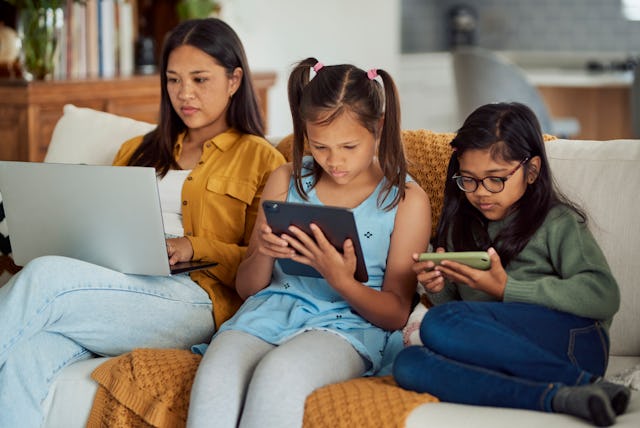A New Study Found That Kids Model Their Parents' Screen Habits More Than We Might Think
There are three habits in particular that parents can stop to help their kids.

In the world of mom guilt, screens are a powerful adversary. We struggle to find balance between embracing technology’s conveniences (like its eerie power to stop children from whining), and protecting our kids from less desirable consequences (like screen addiction or mental health issues). Now, a new study has found that how parents are handling media their own social media use could affect how their kids treat screens.
Researchers analyzed data from over 10,000 families with 12-13-year-olds. The data is from an ongoing longterm study focusing on Adolescent Brain and Cognitive Development (ABCD). The recent analysis results, published in Pediatric Research, suggest the best way to control your adolescent screen time is to start with looking yourself in the mirror.
Probably not the news you wanted to hear.
It feels obvious and yet is not an easy pill to swallow: How we as parents use screens sets the standard for how screens are used in our home.
More screen use by adolescents, and problematic social media, video game, and mobile phone use were all associated with parents who:
- Use screens around their children.
- Allow screens at meal times.
- Bring screens to bed.
About 73% of parents said they use screens around their adolescents. Imitation might be the sincerest form of flattery, but as parents it can be the hardest to reckon with.
The study also explored how using screen time as a reward or punishment worked in controlling adolescent use. Interestingly, when parents leveraged screens this way, kids ended up spending more time on them.
Screens are addictive because social media and video games target the dopamine reward centers of our brains. It makes sense that strengthening the connection to screentime as a reward (and withholding it as punishment) can lead to problematic use. How easy is it to indulge in mindless scrolling as a “little treat” for ourselves in the midst of a busy day? Ideally, our children will look to healthier, more sustainable self-care tactics.
Another issue with using screens to control behavior is a problem that far outdates smart devices: Preteens and teens are famously NOT fond of being told what to do. Attempts at control are rejected on principle. Attempts to control with a “do as I say, not as I do,” strategy are especially likely to backfire.
So let’s say you haven’t modeled ideal behavior, if the disciplinarian route is ineffective, what now?
Don’t lose hope, because parental involvement can make a difference. Parental monitoring and limit-setting led to lower screen time and less problematic use. Rules, boundaries, and supervision are still effective. Dr. Ken Ginsberg, a professor of pediatrics at Children’s Hospital of Philadelphia who was not involved in the study, suggests beginning a conversation around screen-free zones or times with “I set rules because I care.”
We can’t control everything, but that doesn’t mean we have to stick our heads in the sand. There is no magic sticker chart or comprehensive system to unlock positive influence over our adolescent children. The study’s findings speak to the power of active engagement with our childrens’ screen use, in their lives, and in our own lives. Even though it’s hard on top of everything else.
Do we use screens to nurture curiosity? To learn? To share a laugh? Our kids are watching. Do we use screens to escape stress? To numb? To seek validation? Our kids are watching. Our work is to stay engaged in what we value, online and off.
Social media has as much power to connect as to isolate, and technology has the same spectrum of potential in our individual relationships. When we know what our kids are up to and set healthy limits that we model ourselves, we become teammates instead of adversaries. We can navigate the changing landscape beaming from our pocket rectangles together.